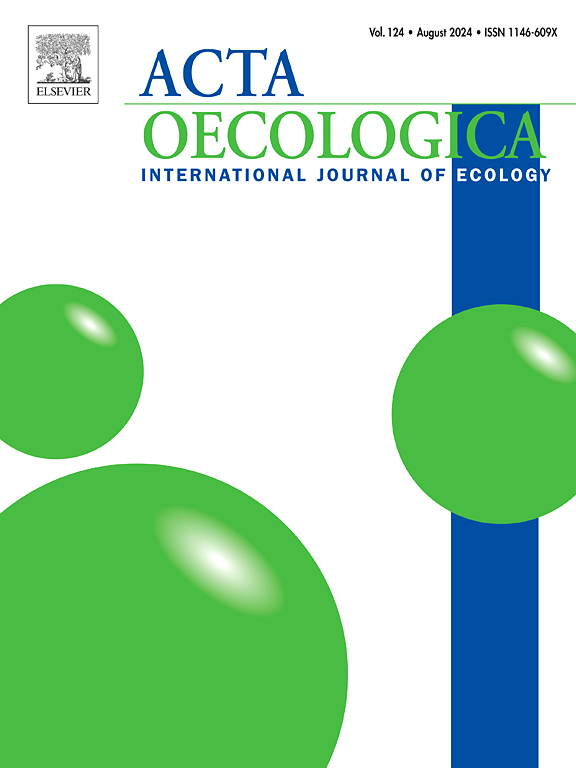Daily changes in the tropical soundscape: the acoustic partition between birds and insects in a forest in southern Vietnam
IF 1.3
4区 环境科学与生态学
Q3 ECOLOGY
Acta Oecologica-International Journal of Ecology
Pub Date : 2025-06-12
DOI:10.1016/j.actao.2025.104101
引用次数: 0
Abstract
Animals communicating through acoustic signaling may compete for “acoustic space”. In tropical rainforests, birds and insects are the most acoustically active animals during the daytime, and insects are considered a major source of noise for singing birds. However, the extent to which birds and insects partition acoustic space in tropical forests is poorly known. We analyzed bird and insect acoustic activity at different time scales using passive acoustic monitoring data collected over a year in southern Vietnam. Recordings were made for 5 min every 25 min over 24-h periods, which allowed us to investigate temporal dynamics at daily and seasonal scales. We first calculated acoustic indices for all 5-min recordings across the full dataset. To assess finer-scale interactions, we also sampled 100 recordings representing various times of day and seasons. Then, we assessed the elements of the soundscape (biophony, geophony, and anthropophony) in each recording. Insects and birds were the main elements of the daytime biophony, with insect sounds being most prominent. Insects were active both day and night, but their activity decreased at dawn, when bird activity peaked. We found no negative relationship between insect and bird sound occurrences in the selected recordings, suggesting that birds do not avoid periods of insect activity. Instead, the observed patterns likely reflect distinct circadian rhythms. Furthermore, insects calling at the same frequencies as birds usually do not produce sounds actively at dawn, when birds are the most active. This may contribute to increased acoustic partitioning between birds and insects.
热带声景观的日常变化:越南南部森林中鸟类和昆虫之间的声隔断
通过声音信号进行交流的动物可能会争夺“声音空间”。在热带雨林中,鸟类和昆虫是白天声音最活跃的动物,昆虫被认为是唱歌的鸟类的主要噪音来源。然而,鸟类和昆虫在多大程度上划分了热带森林的声学空间,人们知之甚少。我们利用在越南南部收集的一年多的被动声学监测数据,分析了不同时间尺度下鸟类和昆虫的声学活动。在24小时的时间段内,每25分钟记录5分钟,这使我们能够在日常和季节尺度上研究时间动态。我们首先计算了整个数据集中所有5分钟录音的声学指数。为了评估更精细的相互作用,我们还采样了100个代表一天中不同时间和季节的记录。然后,我们评估了每个录音中的声景元素(生物声、地声和人声)。昆虫和鸟类是白天生物鸣声的主要组成部分,其中昆虫的声音最为突出。昆虫在白天和晚上都很活跃,但在黎明时它们的活动减少,而此时鸟类的活动达到顶峰。在选定的录音中,我们发现昆虫和鸟类的声音之间没有负相关关系,这表明鸟类不会避开昆虫活动的时期。相反,观察到的模式可能反映了不同的昼夜节律。此外,以与鸟类相同频率鸣叫的昆虫通常不会在黎明发出积极的声音,而此时鸟类是最活跃的。这可能有助于增加鸟类和昆虫之间的声学划分。
本文章由计算机程序翻译,如有差异,请以英文原文为准。
求助全文
约1分钟内获得全文
求助全文
来源期刊
CiteScore
3.60
自引率
0.00%
发文量
57
审稿时长
>0 weeks
期刊介绍:
Acta Oecologica is venue for the publication of original research articles in ecology. We encourage studies in all areas of ecology, including ecosystem ecology, community ecology, population ecology, conservation ecology and evolutionary ecology. There is no bias with respect to taxon, biome or geographic area. Both theoretical and empirical papers are welcome, but combinations are particularly sought. Priority is given to papers based on explicitly stated hypotheses. Acta Oecologica also accepts review papers.

 求助内容:
求助内容: 应助结果提醒方式:
应助结果提醒方式:


